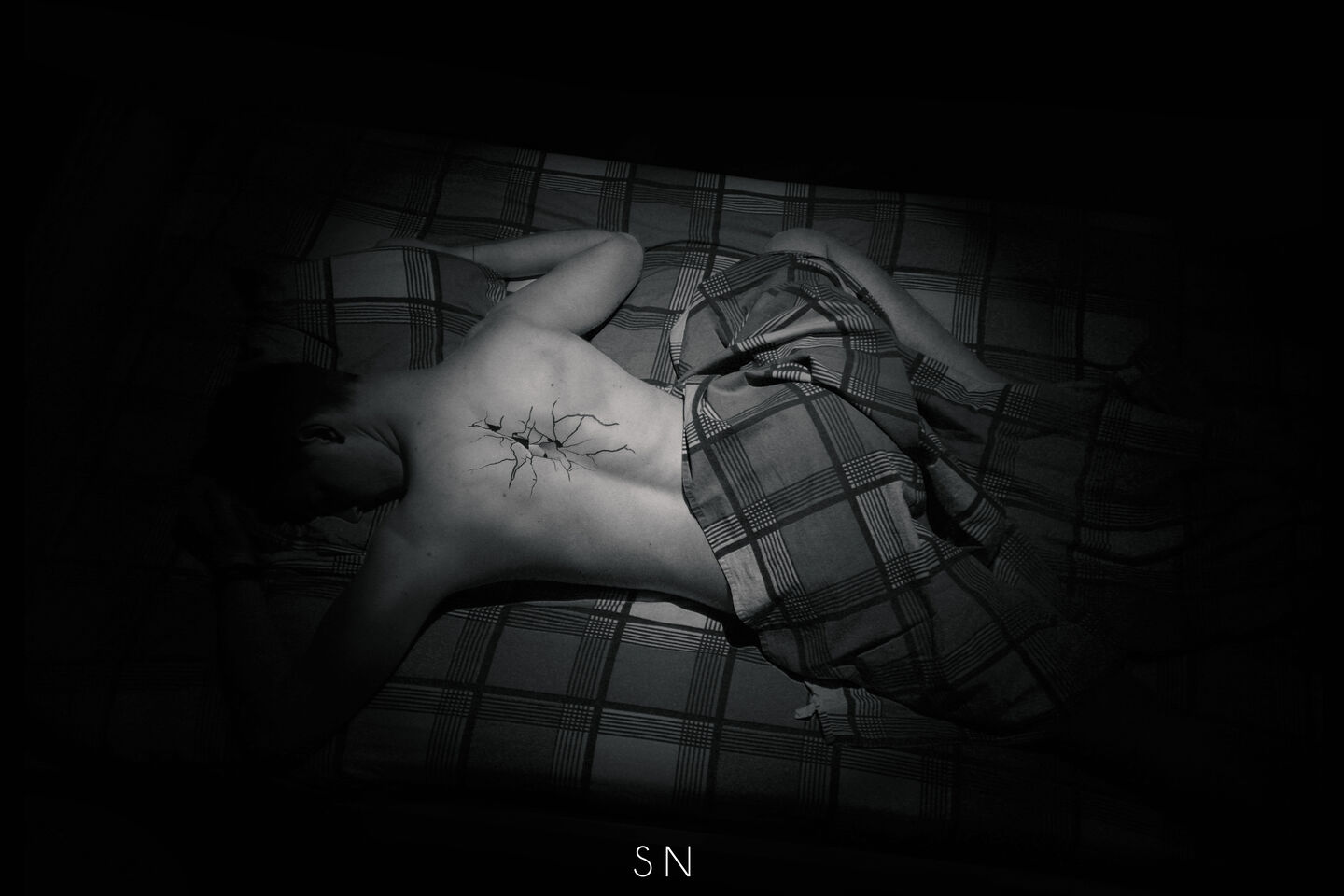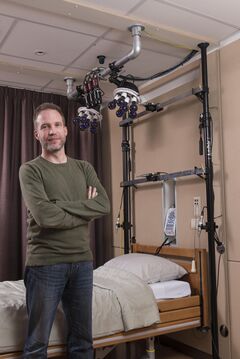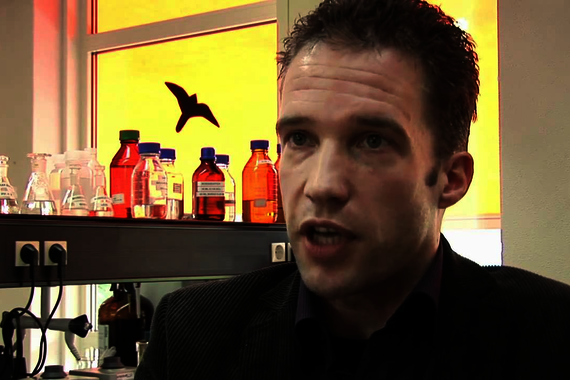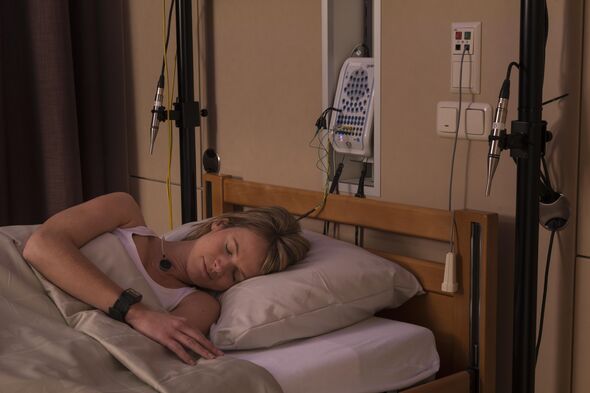
A story about bedtime
Imagine waking up after an apparently good night's sleep yet not feeling rested. It happens to countless people every day, but the cause of this and other sleep problems such as apnea, narcolepsy and sleepwalking can often be difficult to establish. Sleep physician and TU/e professor Sebastiaan Overeem is therefore using smart technology to measure the quality of sleep without disturbing the sleeper – and to find out how your behavior throughout the day affects your next night's sleep.
Anyone sat across from Sebastiaan Overeem in his office in Flux – jeans and sneakers, beard stubble, athletic look - sees someone who bears no resemblance to the traditional notion of a dried-out physician and stuffy old scientist. Yet Overeem is both physician and scientist: half his time he spends working as a somnologist (sleep physician) at sleep clinic Kempenhaeghe in Heeze, the remainder of his working week he can be found researching sleep disorders – part of the time at TU/e, where for a couple of years now he been a part-time professor.
Sleep is notoriously difficult to research, the researcher points out: “During sleep, it is obviously not possible to talk with the patient, and afterwards he or she often has no memories of that period.” Serious progress in the field was therefore only made with the advent of the electroencephalogram (EEG), in the 1920s. Electrodes taped to the skull are used to measure minimal electrical signals in the brain.
Rapid eye movements
“When REM sleep was described in the fifties that was another significant step forward,” continues Overeem. REM stands for Rapid Eye Movement - a characteristic of this type of sleep. “This is the sleep phase in which we dream. At this time it was also realized that when we are sleeping our brains are not resting at all, quite the opposite in fact: during REM sleep our brain uses even more energy than when we are awake.”
But to prevent accidents, it is normal for all our skeletal muscles to relax during REM sleep, with the exception of the eye muscles and those muscles needed to breathe. In REM Sleep Behavior Disorder – a well-known disorder – this relaxation does not occur, the sleep physician explains, so that people end up acting out their dreams in bed, often in a violent manner by kicking, hitting or biting – highly unsettling, especially for the patient's partner.
“And this is very different from sleepwalking, which stems from deep sleep. The best thing you can do for a sleepwalker is guide them back to bed because it is very difficult to wake them. Fortunately, people can be woken from REM sleep quite easily, and so they can often tell us exactly what they were dreaming at that moment.”
Parkinson's
This disorder provides a good example of how sleep research can be valuable to other fields of medicine, says Overeem: “It turns out, you see, that many people with REM Sleep Behavior Disorder later develop Parkinson's disease. In a sense, it is an initial stage of this disease, when it has reached only the brainstem. Later, once the substantia nigra in the midbrain has been affected, the shaking starts that people associate with Parkinson's. And at an even later stage, the cerebrum (the main part of the brain) is affected, which results in dementia.”
The text continues below the movie.
Narcolepsy
Overeem studied medicine and neurosciences at Leiden, where he also received his doctorate. In the early days of his PhD studies he spent time at Stanford University, and was involved in pioneering research on the causes of narcolepsy, a disorder in which the ‘sleep-wake switch’ in the brain is so disturbed that patients fall asleep without warning during the day (and conversely wake up repeatedly at night).
Although long a topic of controversy, we can now point to two areas of the brain responsible for the transition between ‘sleeping’ and ‘waking’. “When we are awake, the 'wakeful center' ensures that activity in the 'sleep center' is inhibited and vice versa,” the professor explains. This ensures that we don't live in a permanent state of semi-wakefulness. “Having this feedback in the brain gives rise to a switch of sorts that is either on or off; in electrical engineering this type of circuit is called a flip-flop. One of its effects, for example, is that you can't remember the moment of falling asleep – it doesn't happen gradually, but very quickly, as if quite literally a switch is flipped.”
The protein hypocretin ensures that in healthy people this sleep switch isn't flipped at the drop of a hat. But people with narcolepsy lack this protein, as Overeem and his colleagues in Stanford demonstrated in 2000, so that even a slight sleep stimulus causes them to fall asleep instantly.
Feedback between the centers for sleep and wakefulness in our brain creates some kind of switch which can be either on or off
Nonetheless, there is as yet no medicine for narcolepsy based on hypocretin. “It is very difficult to get precisely this substance into the brain,” he explains. “The medicine has to cross a barrier between the bloodstream and the brain, and we still haven't managed that. However, just recently sleeping pills became available that temporarily block the brain's receptors for hypocretin. These are easier to make because they don't have to fit into the receptor precisely.”
Sleep diagnostics
These days Overeem, who has held the chair 'Intelligent Systems for Sleep Disorders' at TU/e since last year, works chiefly on the diagnostics of sleep disorders. It is, after all, impracticable to subject everyone who regularly sleeps badly to sleep research like that conducted in a clinic like Kempenhaeghe. Added to which, in such a setting hardly anyone sleeps as they do at home – and having a scalp full of electrodes doesn't help at all.
“This is why we are looking for ways to measure sleep that don't involve looking directly at the brain,” says the researcher. “For a method that doesn't disturb sleep and can be applied at home, preferably on a series of consecutive nights. One option is to use a smart watch that measures movement and heart rate; the value of this has been demonstrated by our PhD candidate Pedro Fonseca. And by looking at the variation in heart rate, you can also learn something about the breathing. In healthy people, we can already distinguish the various sleep phases. The next challenge is to do the same in patients with sleep disorders.”
This follow-up research is taking place in cooperation with, among others, Philips – also Fonseca's employer – under the auspices of the Eindhoven MedTech Innovation Center (e/MTIC), to which Kempenhaeghe, Catharina Hospital and Máxima Medical Center are also affiliated. As well as smart watches, the possibilities offered by infrared cameras will also be investigated. “They too allow you to record movements during sleep, and again reveal the heart rate, this time from the blood circulation in the skin. Mark van Gastel will obtain his doctorate in December with us for his work on the technical development of this technology.”
The text continues below the image.
Frame of mind
In addition, Overeem has started a research line in which the influence of daytime activities on sleep and vice versa are measured, rather than sleep itself. “The research conducted by Maaike Goelema, who received her PhD in February from the Department of Industrial Design, shows that the frame of mind or mood a person is experiencing when they go to bed plays a surprisingly large role in whether they feel rested the next day. To really rest you have to go to bed feeling quite relaxed. As a doctor, I can hardly call this is a sleep disorder, but it does have a considerable impact on a person's wellbeing.”
And because he would prefer to measure what someone does during the day, rather than ask how many cups of coffee that person has drunk, and how late in the day exactly, plans are also afoot to supplement questionnaires with all kinds of smart measurements. Taken using the smart watch mentioned above, for example, but also, say, using domestic devices that are increasingly likely to have a wireless internet connection. “We want to start using the Internet of Things to see when a coffee-maker was switched on, and whether someone opened the fridge. In this way, we can extend the sleep research to 24 hours a day. Because, after all, the basis for a good night's sleep is laid in the morning.”




Discussion